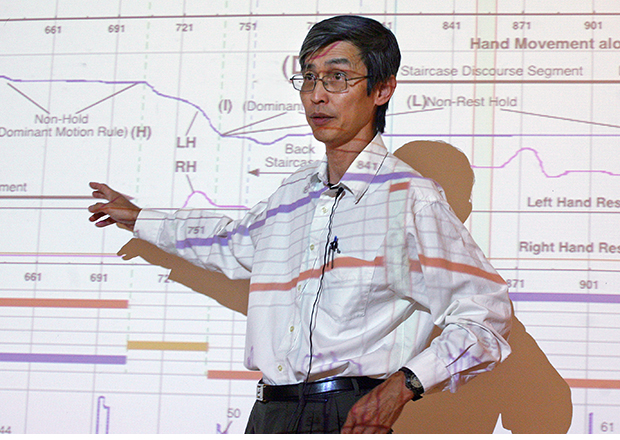TAMU initiative draws renowned researcher to visualization faculty

Francis Quek
Francis Quek, who joined the [Department of Visualization] (http://viz.arch.tamu.edu) in the fall 2013 semester as part of an initiative by The Texas A&M System to attract top-notch faculty, will heighten the department’s involvement regarding the interaction between people and technology.
He brings significant research experience in physical computing and interaction design, said Tim McLaughlin, head of the department.
Physical computing, in the broadest sense, is using software and hardware to building interactive physical systems that can sense and respond to the analog world, such as those used in an interactive art exhibit. Interaction design, on the other hand, aims to make computing technology more suitable, engaging and responsive to users.
Quek’s research uses the physical environment as a medium to interact with digital technology, with a focus on language, education and special populations, including children, older adults and the blind.
“He's dynamic in his capacity to generate ideas, is committed to building interdisciplinary teams and has a strong track record in developing innovative uses of interactive visual computing for teaching and learning,” said McLaughlin.
Quek came to Texas A&M as part of the [Chancellor’s Research Initiative] (http://news.tamus.edu/2012/08/01/tamus-chancellor-john-sharp-to-announces-100-million-research-initiative/) , which provides funds to recruit and hire top faculty members.
“We have some of the best universities in the country, and we want to attract exceptional faculty members who will have a transformative impact upon the academic and research missions of Texas A&M and Prairie View A&M,” said John Sharp, system chancellor.
At Texas A&M Quek has continued to demonstrate his academic prowess, earning best paper honors with two colleagues at the Oct. 2013 [International Conference on Interactive Storytelling] (http://gamesandnarrative.net/icids2013/) for proposing the development of a computer application that helps a child digitally “paint” or “sketch” a story using motions, gestures or actions.
In such a system, said Quek, the child is able to focus on actualizing ideas instead of the rules and peculiarities of language.
“She is able,” he said, offering an example, “to characterize ideas with subtleties and nuances she imagines, but may not yet have the competence to express, adding richness and texture to her story, using complex gestures of wings flapping rather than writing ‘the bird is flying.’”
The proposal is based on the team’s research that shows children 8-10 years old become better and more coherent storytellers if they physically reenact stories they hear. Storytelling is important, said Quek, because of its central role in education, especially in elementary school curricula.
Quek came to Texas A&M from Virginia Tech, where he founded and directed the [Vision Interfaces and Systems Laboratory] (http://vislab.cs.vt.edu) , which investigates human-computer interaction, medical imaging and computer vision.
He earned bachelor’s and master’s degrees in electrical engineering and a Ph.D. in computer science in engineering from the University of Michigan. He also hold a degree in electronics and communication engineering from Singapore Polytechnic.
His research in human-computer interaction and computer vision is particularly relevant to K-12 science, technology, engineering and mathematics (STEM) education and in the training of individuals with disabilities, such as blindness.
Quek also writes [poetry] (http://vislab.cs.vt.edu/~quek/) and enjoys [woodworking] (http://vislab.cs.vt.edu/~quek/) .
Previous post
Tags
- applied creativity
- building a better texas
- feature
- research
- rss
- technology
- visualization
- viz gallery
Related Posts

Initiative fusing arts, technology education gains momentum

Teacher 'making’ workshop fosters STEM education

Micro-manufacturing initiative earns NSF Convergence Award
NSF group melding art, science learning
Follow Us
Facebook Twitter Vimeo Youtube Flickr RSS
Recent Posts

Planning prof heads study of disaster housing aid

A message from the dean

Former student remembered as expert planner

Leading educator named new head of Architecture Dept.






_thumbnail_small.png)
